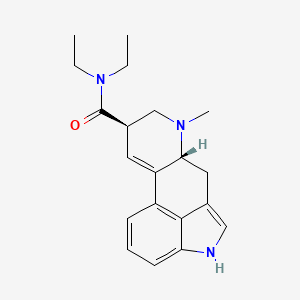|
Name: Lysergic acid diethylamide
Type: Hallucinogen
AKA: LSD, lysergide, acid, tabs, drops

|
|
II. Natural Derivative

|
|
III. Chemical Profile (IUPAC name)

|
|
IV. History
Lysergic Acid Diethylamide (LSD), a powerful hallucinogen, was first synthesized in 1938. It gained prominence in the 1960s counterculture movement and remains a significant substance in psychedelic research.

|
|
V. Legal Information
Lysergic Acid Diethylamide (LSD) is a powerful hallucinogen. It is tightly controlled under drug laws due to its potential for abuse and profound effects on mental health. [Source: UNODC].
US Federal Schedule - I
Schedule I drugs, substances, or chemicals are defined as drugs with no currently accepted medical use and a high potential for abuse. Some examples of Schedule I drugs are: heroin, lysergic acid diethylamide (LSD), marijuana (cannabis), 3,4-methylenedioxymethamphetamine (ecstasy), methaqualone, and peyote.
Key US Federal Policies:
Controlled Substances Act. Public Law: Public Law 91-513 (text can be found on GovInfo) (https://www.dea.gov/drug-information/csa). Date enacted: October 27, 1970.
|
|
VI. Physical Effects
Lysergic Acid Diethylamide (LSD) is a potent hallucinogen that alters perception and mood. As a psychedelic, it causes dilated pupils, altered sensory perception, and emotional changes. Short-term use leads to profound changes in consciousness, while long-term use may cause psychological effects but not physical damage. Overdose risks are minimal but can include psychological distress. Safe use involves controlled settings. Recent research explores its therapeutic potential for mental health conditions.  |
|
VII. Psychological Effects
LSD is a potent hallucinogen that alters perception and cognition. Short-term effects include intense hallucinations and mood changes, while long-term use may result in persistent psychological effects. Research indicates its impact on serotonin receptors and associated mental health risks.
 |
|
VIII. Culture
Lysergic acid diethylamide (LSD) was synthesized in the 1930s and became known for its psychedelic effects in the 1960s counterculture. Its cultural impact includes its role in the psychedelic movement and debates about its therapeutic potential. Proponents argue for its use in psychotherapy and consciousness exploration, while opponents focus on safety concerns and its association with drug culture. Its use is both recreational and research-oriented, reflecting ongoing interest in psychedelics.
 |
